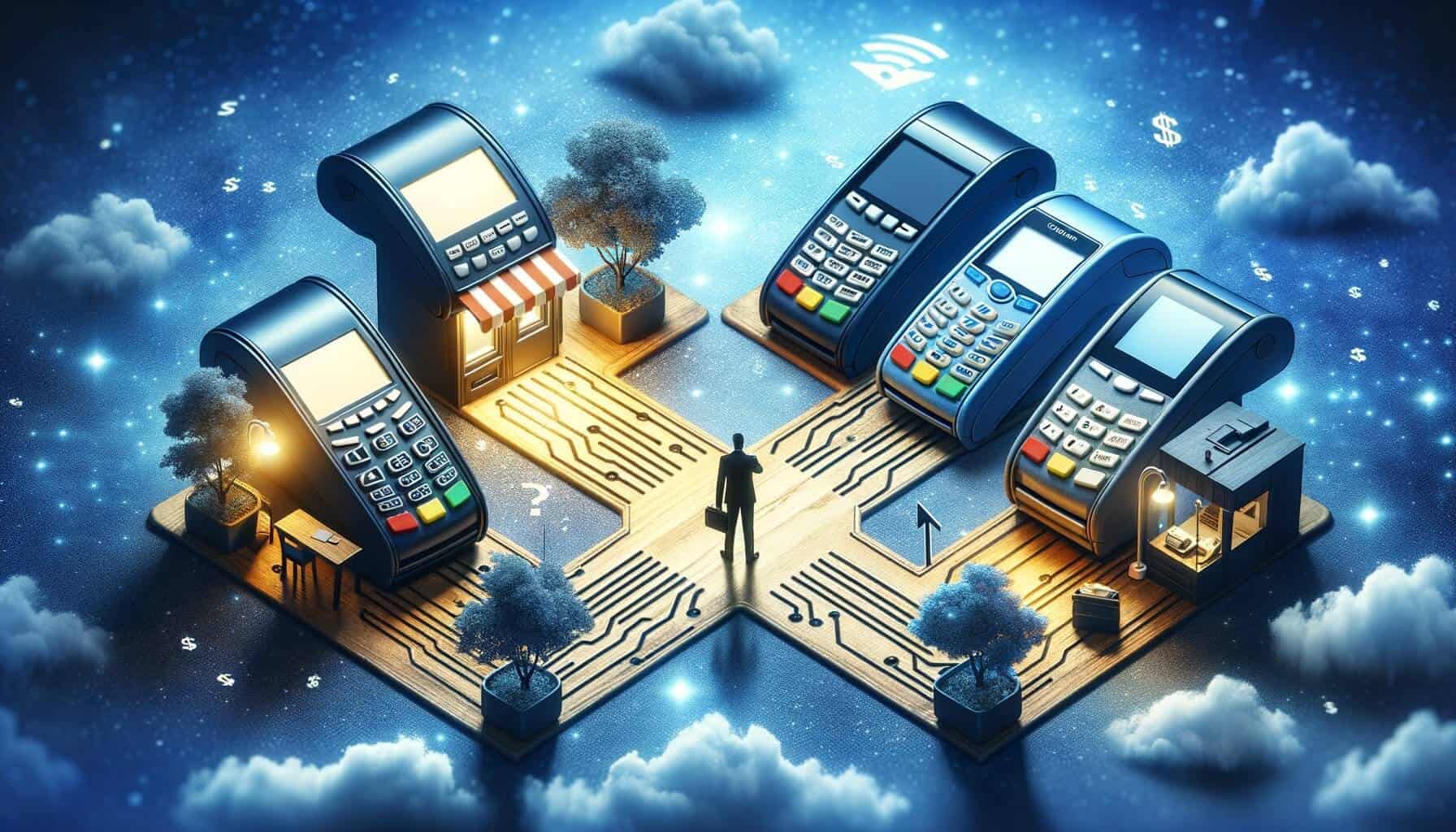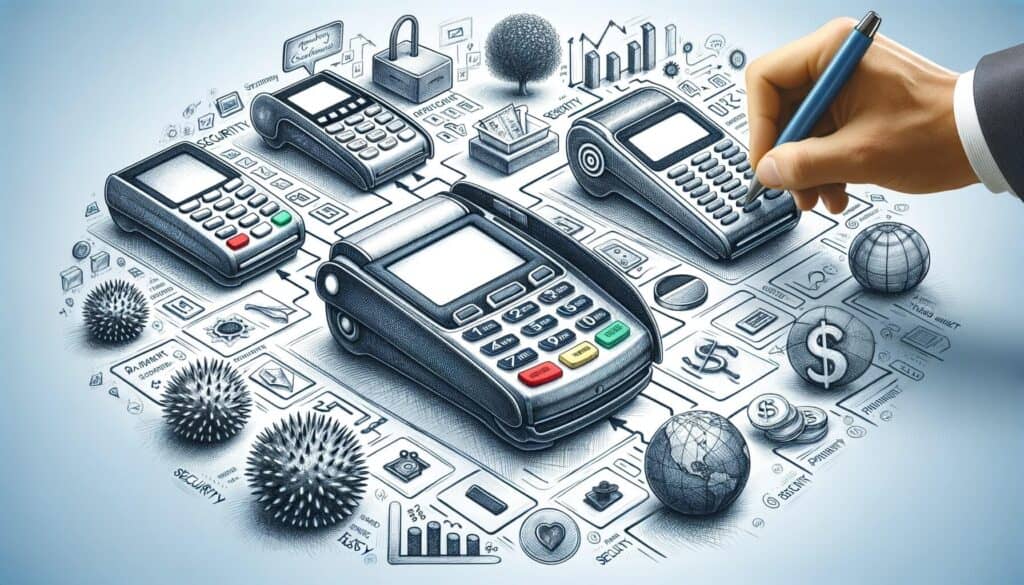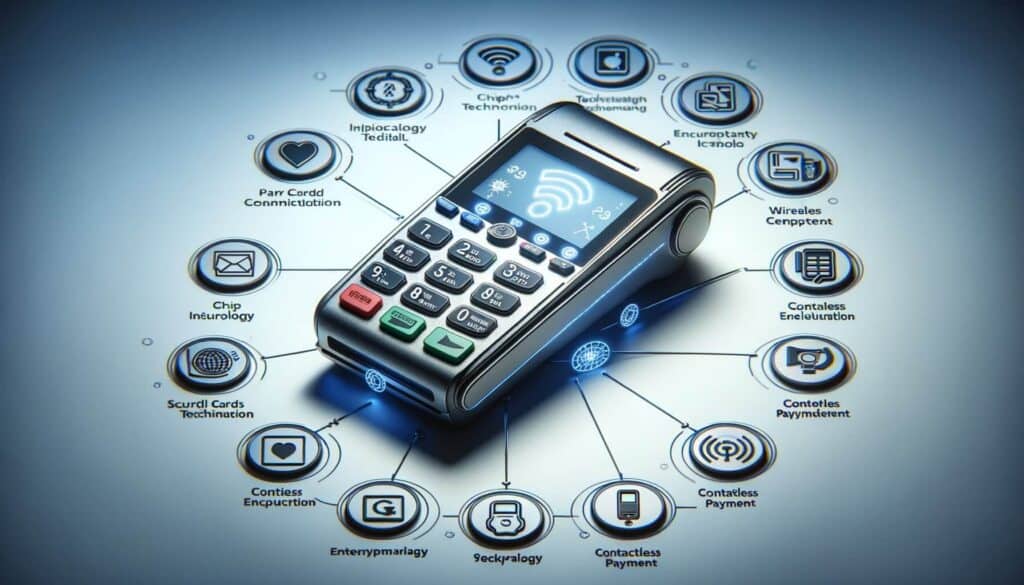
By Harriet Forster March 25, 2025
In today’s digital age, accepting credit card payments is essential for businesses of all sizes. To facilitate these transactions, a credit card terminal is a crucial tool. However, with the wide range of options available in the market, choosing the right credit card terminal for your business can be a daunting task.
This comprehensive guide will walk you through the factors to consider, types of credit card terminals, key features to look for, payment processing methods, security measures, costs and fees, and a comparison of different providers. By the end of this article, you will be equipped with the knowledge to make an informed decision for your business’s credit card terminal.
Factors to Consider When Choosing a Credit Card Terminal for Your Business

1. Business Type and Size: The first factor to consider is the nature and size of your business. Retail stores, restaurants, and e-commerce businesses have different requirements. Determine whether you need a countertop terminal, mobile terminal, or an online payment gateway.
2. Connectivity Options: Consider the connectivity options available for the credit-card-terminal. Traditional terminals use phone lines, while modern ones use internet connections or wireless networks. Choose the option that suits your business’s infrastructure and location.
3. Compatibility: Ensure that the credit card terminal is compatible with your existing point-of-sale (POS) system or software. Integration between the terminal and your POS system will streamline operations and improve efficiency.
4. Ease of Use: Look for a credit-card-terminal that is user-friendly and intuitive. Your staff should be able to quickly learn how to operate it, reducing training time and potential errors during transactions.
5. Customer Support: Check the availability and quality of customer support provided by the terminal provider. Prompt and reliable support is crucial in case of any technical issues or questions that may arise.
6. Scalability: Consider the future growth of your business. Choose a credit card terminal that can accommodate increasing transaction volumes and additional features as your business expands.
7. Brand Reputation: Research the reputation of the credit-card-terminal brand. Look for reviews, testimonials, and ratings from other businesses to ensure reliability and customer satisfaction.
8. Durability and Longevity: Invest in a credit card terminal that is built to last. Consider the durability of the device and the availability of software updates to ensure its longevity.
9. Customization Options: Some credit-card-terminals offer customization options, such as adding your business logo or changing the display settings. These features can enhance your brand image and provide a personalized experience for your customers.
10. Cost: Finally, consider the cost of the credit card terminal, including the initial purchase price, ongoing fees, and transaction charges. Compare different options to find the best value for your business.
Types of Credit Card Terminals: Exploring the Options Available
1. Countertop Terminals: Countertop terminals are the most common type and are suitable for businesses with a fixed location, such as retail stores and restaurants. They are connected to a phone line or internet connection and are typically placed near the cash register.
2. Mobile Terminals: Mobile terminals are ideal for businesses that require flexibility and mobility, such as food trucks, delivery services, and trade shows. These terminals connect wirelessly to a smartphone or tablet, allowing transactions to be processed anywhere with a cellular or Wi-Fi connection.
3. Virtual Terminals: Virtual terminals are used for online or phone-based transactions. They allow businesses to manually enter credit card information into a secure online portal. Virtual terminals are suitable for e-commerce businesses or those that accept payments over the phone.
4. Point-of-Sale (POS) Systems: POS systems combine a credit card terminal with additional features, such as inventory management, employee tracking, and sales reporting. They are suitable for businesses that require a comprehensive solution for their operations.
Key Features to Look for in a Credit Card Terminal

1. EMV Chip Card Reader: Ensure that the credit-card-terminal has an EMV chip card reader. EMV technology provides enhanced security by encrypting transaction data and reducing the risk of counterfeit card fraud.
2. Near Field Communication (NFC) Capability: Look for a credit card terminal that supports NFC payments, such as Apple Pay and Google Pay. NFC technology allows customers to make contactless payments by simply tapping their mobile devices or cards on the terminal.
3. Receipt Printing Options: Consider whether you need a credit-card-terminal with built-in receipt printing capabilities or if you prefer to send digital receipts via email or SMS. Some terminals offer both options for added convenience.
4. Touchscreen Display: A touchscreen display can improve the user experience and make transactions faster and more efficient. Look for a credit card terminal with a responsive and intuitive touchscreen interface.
5. Multiple Payment Options: Ensure that the credit-card-terminal can accept various payment methods, including credit cards, debit cards, mobile payments, and gift cards. Offering multiple payment options can enhance customer satisfaction and increase sales.
6. Offline Mode: In case of internet or network connectivity issues, having an offline mode feature allows the credit card terminal to continue processing transactions. This ensures uninterrupted service and prevents loss of sales.
7. Integration with POS Systems: If you already have a POS system in place, choose a credit-card-terminal that seamlessly integrates with it. Integration eliminates the need for manual data entry and improves accuracy and efficiency.
8. Reporting and Analytics: Look for a credit card terminal that provides detailed reporting and analytics features. These insights can help you track sales, identify trends, and make informed business decisions.
9. Multi-Currency Support: If your business deals with international customers or operates in multiple countries, consider a credit card terminal that supports multiple currencies. This feature simplifies transactions and eliminates the need for currency conversion.
10. Contactless Payment Limit: Check the contactless payment limit of the credit card terminal. Some terminals have a maximum transaction amount for contactless payments, which may impact certain businesses.
Understanding the Different Payment Processing Methods

1. Magnetic Stripe: Magnetic stripe cards are the traditional method of payment processing. The customer swipes their card through the terminal, and the magnetic stripe on the back of the card is read to authorize the transaction. However, this method is becoming less common due to security concerns.
2. EMV Chip: EMV chip cards are the most secure payment method available. The customer inserts their card into the terminal, and the chip on the card generates a unique transaction code for each transaction, making it difficult for fraudsters to replicate.
3. Near Field Communication (NFC): NFC payments use contactless technology to enable transactions. The customer simply taps their mobile device or card on the terminal, and the payment is processed. NFC payments are fast, convenient, and secure.
4. Mobile Wallets: Mobile wallets, such as Apple Pay and Google Pay, allow customers to store their credit card information on their smartphones. They can then make payments by holding their device near the credit card terminal. Mobile wallets offer convenience and enhanced security.
Evaluating the Security Measures of Credit Card Terminals
1. EMV Compliance: Ensure that the credit card terminal is EMV compliant. EMV technology provides an added layer of security by encrypting transaction data and reducing the risk of counterfeit card fraud.
2. Point-to-Point Encryption (P2PE): P2PE is a security measure that encrypts cardholder data from the moment it is entered into the credit card terminal until it reaches the payment processor. This prevents unauthorized access to sensitive information.
3. Tokenization: Tokenization replaces sensitive cardholder data with a unique token. This token is used for transaction processing, while the actual card data is securely stored by the payment processor. Tokenization reduces the risk of data breaches and enhances security.
4. PCI Compliance: Payment Card Industry Data Security Standard (PCI DSS) compliance is essential for businesses that handle credit card information. Ensure that the credit card terminal and the payment processor are PCI compliant to protect customer data.
5. Secure Network Connections: Look for credit card terminals that use secure network connections, such as SSL or TLS, to transmit transaction data. This ensures that the data is encrypted and protected from interception.
6. Secure Passwords: Choose a credit card terminal that allows you to set secure passwords for accessing the device and making configuration changes. Strong passwords are essential to prevent unauthorized access.
7. Regular Software Updates: Regular software updates are crucial for maintaining the security of the credit card terminal. Updates often include security patches and bug fixes that address vulnerabilities and protect against emerging threats.
Assessing the Costs and Fees Associated with Credit Card Terminals
1. Purchase Price: The initial purchase price of a credit card terminal can vary depending on the brand, model, and features. Consider your budget and the long-term value of the terminal when making a purchase decision.
2. Transaction Fees: Transaction fees are charged by the payment processor for each credit card transaction. These fees can be a flat rate or a percentage of the transaction amount. Compare the transaction fees of different providers to find the most cost-effective option for your business.
3. Monthly Fees: Some credit card terminal providers charge monthly fees for the use of their services. These fees may cover customer support, software updates, and additional features. Consider the value provided by these services when evaluating the monthly fees.
4. Equipment Leasing: Instead of purchasing a credit card terminal outright, some businesses choose to lease the equipment. Leasing can be a cost-effective option for businesses with limited upfront capital, but it may result in higher overall costs in the long run.
5. Cancellation Fees: Be aware of any cancellation fees associated with credit card terminal contracts. These fees may apply if you decide to switch providers or terminate the contract before the agreed-upon term.
6. Chargeback Fees: Chargeback fees are charged by the payment processor when a customer disputes a transaction and requests a refund. These fees can vary depending on the provider and can significantly impact your bottom line if chargebacks are frequent.
7. PCI Compliance Fees: Some credit card terminal providers charge additional fees for PCI compliance services. These fees cover the cost of maintaining a secure environment for handling credit card data and ensuring compliance with industry standards.
8. Additional Features: Consider any additional features or services offered by the credit card terminal provider. While these features may come at an additional cost, they can provide added value and improve the efficiency of your business operations.
Comparing Different Credit Card Terminal Providers
1. Reputation and Reliability: Research the reputation and reliability of different credit card terminal providers. Look for reviews, testimonials, and ratings from other businesses to gauge customer satisfaction and the quality of service provided.
2. Customer Support: Evaluate the customer support offered by different providers. Consider factors such as availability, response time, and the quality of support provided. Prompt and reliable customer support is crucial in case of any technical issues or questions that may arise.
3. Integration with POS Systems: If you already have a POS system in place, choose a credit card terminal provider that seamlessly integrates with it. Integration eliminates the need for manual data entry and improves accuracy and efficiency.
4. Pricing and Fees: Compare the pricing and fees of different credit card terminal providers. Consider the purchase price, transaction fees, monthly fees, and any additional charges. Look for a provider that offers transparent pricing and competitive rates.
5. Payment Processing Options: Ensure that the credit card terminal provider supports the payment processing options you require, such as credit cards, debit cards, mobile payments, and gift cards. Offering multiple payment options can enhance customer satisfaction and increase sales.
6. Security Measures: Assess the security measures implemented by different credit card terminal providers. Look for features such as EMV compliance, point-to-point encryption, tokenization, and secure network connections. Choose a provider that prioritizes the security of customer data.
7. Scalability and Flexibility: Consider the scalability and flexibility offered by different credit card terminal providers. Choose a provider that can accommodate the future growth of your business and offers additional features or services as your needs evolve.
Frequently Asked Questions (FAQs) about Credit Card Terminals
Q1. What is a credit card terminal?
Answer: A credit card terminal is a device used to process credit card payments. It allows businesses to accept payments from customers using credit cards, debit cards, and other payment methods.
Q2. How do credit card terminals work?
Answer: Credit card terminals read the information stored on a credit card’s magnetic stripe or chip. The terminal communicates with the payment processor to authorize the transaction and transfer funds from the customer’s account to the merchant’s account.
Q3. Can I use my smartphone as a credit card terminal?
Answer: Yes, with the advent of mobile payment solutions, smartphones can be used as credit card terminals. Mobile terminals connect wirelessly to smartphones or tablets, allowing businesses to accept payments on the go.
Q4. What is the difference between a countertop terminal and a mobile terminal?
Answer: A countertop terminal is stationary and typically used in fixed locations, such as retail stores or restaurants. A mobile terminal, on the other hand, is portable and can be used anywhere with a cellular or Wi-Fi connection.
Q5. Are credit card terminals secure?
Answer: Credit card terminals can be secure if they implement the necessary security measures. Look for terminals that are EMV compliant, use point-to-point encryption, and have secure network connections to protect customer data.
Q6. How long does it take to set up a credit card terminal?
Answer: The setup time for a credit card terminal can vary depending on the provider and the complexity of your business’s requirements. Some providers offer plug-and-play terminals that can be set up within minutes, while others may require more extensive configuration.
Q7. Can I accept payments online with a credit card terminal?
Answer: Yes, some credit card terminals offer online payment gateway integration, allowing businesses to accept payments through their website. This feature is particularly useful for e-commerce businesses.
Q8. What should I do if my credit card terminal stops working?
Answer: If your credit card terminal stops working, first check the power source and connectivity. If the issue persists, contact the customer support of your terminal provider for assistance.
Q9. Can I use multiple credit card terminals in my business?
Answer: Yes, businesses with multiple checkout points or locations can use multiple credit card terminals. Ensure that the terminals are compatible with your POS system and can be integrated seamlessly.
Q10. Can I switch credit card terminal providers?
Answer: Yes, you can switch credit card terminal providers if you are not satisfied with your current provider or if you find a better option. However, be aware of any cancellation fees or contractual obligations before making the switch.
Conclusion
Choosing the right credit card terminal for your business is a decision that should not be taken lightly. By considering factors such as your business type and size, connectivity options, security features, cost, integration with POS systems, and customer support, you can make an informed decision that meets your specific requirements.
Additionally, exploring the different types of credit card terminals, key features to look for, understanding payment processing methods, and comparing different providers will further assist you in selecting the best credit card terminal for your business. Remember, a reliable and efficient credit card terminal is not only essential for accepting payments but also plays a crucial role in enhancing customer satisfaction and driving business growth.